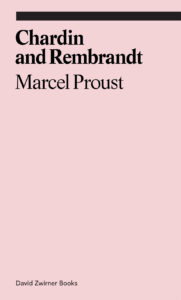The old quarrel between critics and artists (especially painters) plays out with exuberance in two pamphlet-like essays now available from David Zwirner Books. Adding to their charm, both works were written by unmistakable voices from fin-de-siècle France – Marcel Proust and Paul Gauguin – and both beam with a zeal for the art of painting.
The previously untranslated books – Gauguin’s Ramblings of a Wannabe Painter (trans. Donatien Grau) and Proust’s Chardin and Rembrandt (trans. Jennie Feldman) – are notable for their unabashed Frenchness, but they also deserve attention as minor classics of “ekphrasis,” or the translation of one art form into another; in this case, both writers transcribe their experience of paintings into ecstatic prose. As it happens, too, ekphrasis is the name of the series to which these amusing, memorable books belong.
In his essay on Chardin and Rembrandt, a youthful Proust plays the role of critic: he commits a passionate act of ekphrasis by describing master paintings in long, euphoric paragraphs. He’s particularly smitten with Chardin’s “rich depiction of mediocrity,” his elevation of the everyday and commonplace. It’s a bonus that these sections come across as moody prototypes of passages from his In Search of Lost Time – Swann’s Way was first published almost twenty years later.
Gauguin, for his part, spends most of Ramblings of a Wannabe Painter offering hilarious one-liners that convey his disdain for “elite” critics, whom he halfheartedly believes make up a nefarious “Literati.” It doesn’t take him long to compare critics to know-nothing typists, even as he denounces the “erudite” “autocracy” they impose. In Gauguin’s mind, the league of critics is more or less a religion of fools. “You could even call it,” he adds, “theocracy of the typewriter.”
Which is to say that neither of these essays is especially calm: Gauguin refers to his own writing as “the exaggerations of a turbulent mind”; Proust, finally pausing for a breath at the end of his essay, wonders if his intensity would scare Chardin.
For all of their differences in perspective, though, both essayists are at ease in the tempestuous borderland between painting and writing. In some respects, too, Gauguin the Painter and Proust the Novelist share deep affinities.
Despite his good-natured ribbing of the critics of his day, Gauguin is really offering a 19th-century version of Susan Sontag’s “erotics of art” – he believes the “professional” critics, compensating for a lack of feeling, take revenge through order and analysis. (This is why he refers to himself as a “wannabe” or unprofessional painter.) The irony, though, is that Gauguin’s conviction steers him toward an act of criticism. He soon submits a beautiful passage on Renoir, one that Proust would have enjoyed:
In Renoir nothing is in its proper place: don’t look for a line, it doesn’t exist; as if by magic, a pretty patch of color, a caressing light, say enough. A light fuzz shimmers on cheeks, as on a peach, animated by the wind of love whispering its music into waiting ears. One would like to bite the cherry of that mouth – through the laughter a little tooth appears, sharp and white.
And Proust, for all of his exacting intelligence, agrees with Gauguin about the shortcomings of trained perfection. Here he is sounding Gauguin-like while describing Chardin’s The Hard-Working Mother (1740):
The wrist, the hand are no less significant than the rest, and for a viewer who can appreciate it, even a little finger is an excellent exponent of character, playing its role with pleasing accuracy. Only a petty mind, an artist who at most speaks and dresses as such, looks solely for people in whom he recognizes the harmonious proportions of allegorical figures.
For Proust and Gauguin, it isn’t entirely impossible to explain a painting in prose, at least not in its totality, and not through exposition. Both artist agree, for example, that nothing would be more absurd than to describe a painting to its painter. To finesse this point, Proust relies on the absurdity of a near-tasteless metaphor. “It would likewise astonish a woman who has just given birth,” he writes, “to hear a gynecologist describe the physiological process that she, with mysterious strength, has just carried through without knowing its nature.”
A little something extra, these books argue, is required to bridge the gap between painting and prose. You might call it bafflement, indignation, or exuberance. Either way, it’s a surplus of feeling we often find in artists’ writing, from fin-de-siècle France to the present day – at journals like e-flux and Paper Monument. That these unpublished pieces have returned to readers more than a hundred years after their initial publication suggests they retain what the poet Hölderlin called “the saving power.” It’s an argument, I take it, for where we might turn now.
This article was originally published in artnet News, one of our partners.




























